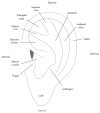The History, Mechanism, and Clinical Application of Auricular Therapy in Traditional Chinese Medicine
- PMID: 26823672
- PMCID: PMC4707384
- DOI: 10.1155/2015/495684
The History, Mechanism, and Clinical Application of Auricular Therapy in Traditional Chinese Medicine
Abstract
Auricular therapy includes acupuncture, electroacupuncture, acupressure, lasering, cauterization, moxibustion, and bloodletting in the auricle. For 2500 years, people have employed auricular therapy for treating diseases, but the methods have been limited to bloodletting and cauterization. Only after 1957, the international scientific community became aware that the map of the ear resembles an inverted fetus, its introduction has led to auricular acupuncture (AA) becoming a more systemic approach, and, following the identification and standardization of more precise points, AA has been employed in clinical applications. The mechanisms of AA are considered to have a close relationship with the autonomic nervous system, the neuroendocrine system, neuroimmunological factors, neuroinflammation, and neural reflex, as well as antioxidation. Auricular therapy has been applied, for example, for pain relief, for the treatment of epilepsy, anxiety, and obesity, and for improving sleep quality. However, the mechanisms and evidence for auricular therapy warrant further study.
Figures
Similar articles
-
Effect of Auricular Acupoint Bloodletting plus Auricular Acupressure on Sleep Quality and Neuroendocrine Level in College Students with Primary Insomnia: A Randomized Controlled Trial.Chin J Integr Med. 2022 Dec;28(12):1096-1104. doi: 10.1007/s11655-022-3581-0. Epub 2022 Nov 3. Chin J Integr Med. 2022. PMID: 36327047 Clinical Trial.
-
A scoping review of mechanisms of auricular acupuncture for treatment of pain.Postgrad Med. 2024 Apr;136(3):255-265. doi: 10.1080/00325481.2024.2333232. Epub 2024 Apr 2. Postgrad Med. 2024. PMID: 38501597
-
Traditional Chinese medicine auricular point acupressure for the relief of pain, fatigue, and gastrointestinal adverse reactions after the injection of novel coronavirus-19 vaccines: a structured summary of a study protocol for a multicentre, three-arm, single-blind, prospective randomized controlled trial.Trials. 2021 Feb 25;22(1):162. doi: 10.1186/s13063-021-05138-3. Trials. 2021. PMID: 33632286 Free PMC article.
-
The efficacy and safety of auricular point combined with moxibustion for insomnia: A protocol for systematic review and meta-analysis.Medicine (Baltimore). 2020 Oct 9;99(41):e22107. doi: 10.1097/MD.0000000000022107. Medicine (Baltimore). 2020. PMID: 33031258 Free PMC article.
-
Risks and Safety of Extended Auricular Therapy: A Review of Reviews and Case Reports of Adverse Events.Pain Med. 2020 Jun 1;21(6):1276-1293. doi: 10.1093/pm/pnz379. Pain Med. 2020. PMID: 32430505 Review.
Cited by
-
The Effects of Auricular Acupressure on Low Back Pain, Neuropathy and Sleep in Patients with Persistent Spinal Pain Syndrome (PSPS): A Single-Blind, Randomized Placebo-Controlled Trial.Int J Environ Res Public Health. 2023 Jan 17;20(3):1705. doi: 10.3390/ijerph20031705. Int J Environ Res Public Health. 2023. PMID: 36767071 Free PMC article. Clinical Trial.
-
Clinical perspectives on vagus nerve stimulation: present and future.Clin Sci (Lond). 2022 May 13;136(9):695-709. doi: 10.1042/CS20210507. Clin Sci (Lond). 2022. PMID: 35536161 Free PMC article. Review.
-
Randomized Crossover Study of Auricular Plaster Therapy to Relieve Dental Anxiety in Children.Front Psychiatry. 2022 May 31;13:862575. doi: 10.3389/fpsyt.2022.862575. eCollection 2022. Front Psychiatry. 2022. PMID: 35711607 Free PMC article.
-
Self-Administration of Auricular Acupuncture in Rural Veterans with Chronic Pain: A Pilot Project.Med Acupunct. 2021 Oct 1;33(5):349-352. doi: 10.1089/acu.2021.0007. Epub 2021 Oct 18. Med Acupunct. 2021. PMID: 35003503 Free PMC article.
-
Traditional Chinese Medicine in Emergency Treatment Mechanism and Application.Open Access Emerg Med. 2020 Apr 30;12:111-119. doi: 10.2147/OAEM.S244110. eCollection 2020. Open Access Emerg Med. 2020. PMID: 32431555 Free PMC article.
References
Publication types
LinkOut - more resources
Full Text Sources
Other Literature Sources
Medical




